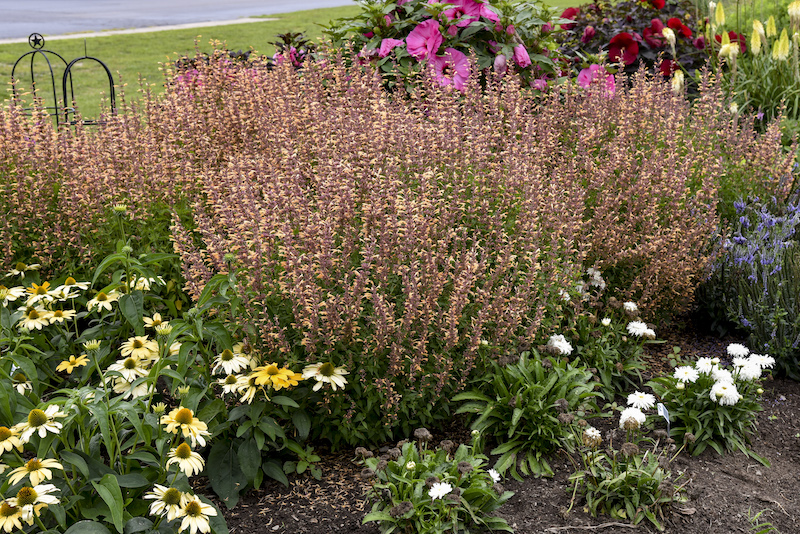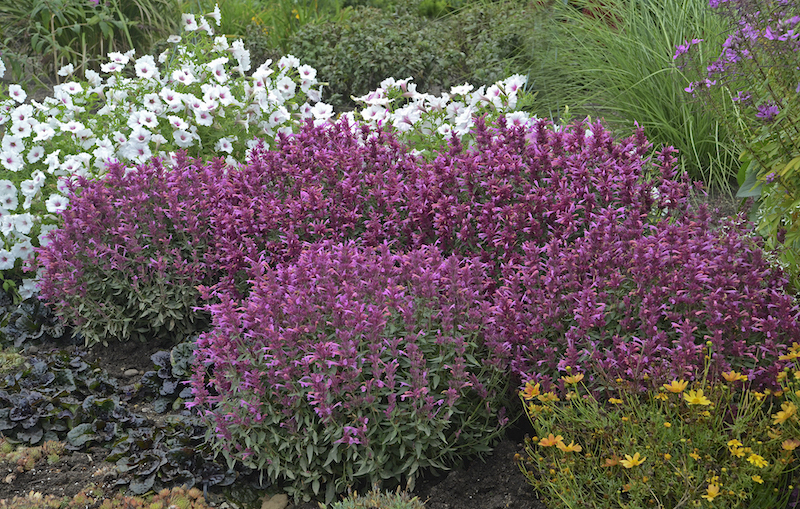No other native plant works harder to attract beneficial pollinators, butterflies, moths, and hummingbirds to your garden than Agastache. This amazingly low-maintenance perennial will happily grow in almost any soil texture or pH level. Supplemental watering is rarely needed once Agastache is fully established, making it a staple in water-wise garden designs. The showy flower spikes of Agastache last through the summer and are fabulous in fresh or dried flower arrangements.
The informal and open growth habit of Agastache lends itself to wildlife-friendly designs like English cottage or country gardens. Its drought tolerance makes it also a good fit for gravel or Mediterranean gardens needing a splash of summer color.

Shrubs To Plant With Agastache
Native flowering shrubs, such as dogwood, serviceberry, snowberry, and mock orange, are a great way to encourage more wildlife into your garden, no matter what size it is. Grow these natives with Agastache in front, which can attract pollinators long after the shrubs have finished flowering.
Agastache comes in a rainbow of colors, allowing it to be used ornamentally with shrubs such as a rose of Sharon, abelia, santolina, and rosemary. Agastache is best suited for less formal areas of the garden due to its ability to self-seed from year to year. The seeding can be controlled by simply deadheading the spent flower spikes or weeding out any unwanted seedlings as they emerge in early spring.
Perennials To Plant With Agastache
Agastache blends effortlessly with wildflowers and native perennials, such as coneflower, red hot poker, coreopsis, and yarrow. All of these plants require little annual maintenance, establish easily, and become drought tolerant at maturity. Non-native plants can also make good companions as long as they tolerate drier soil and full sun. Some outstanding options include shasta daisies, ornamental grasses, bearded iris, and daylilies. Hardy ground covers like ajuga and creeping Jenny can be planted in front as a living mulch to help suppress weeds during the growing season.

Annuals To Plant With Agastache
Pair Agastache with drought-tolerant annuals that do not require supplemental fertilizing through the summer. Some of the best annuals include cosmos, zinnias, marigolds, and snapdragons, which often self-seed and create ‘wild’ areas of seasonal color. These taller annuals provide dense cover for beneficial insects and small animals not only in the summer but also through the winter. More formal planting areas will look lovely with brightly colored Agastache planted behind petunias and calibrachoa edging the bed. Regular deadheading of all the plants will ensure constant blooming and compact growth.
Best Companion Plants For Agastache in Containers
Agastache can be used for container gardening on a deck, patio, or balcony. These herbaceous perennials will live quite happily planted alone in a container with at least a 12-inch diameter. In larger planters, Agastache can be grown with filler and spiller plants such as calendula, small drumstick alliums, or creeping Jenny. These plant combinations require minimal maintenance and will not compete for root growth.
Ensure that your container has plenty of drainage holes at the bottom and use an all-purpose potting mix without added fertilizers. Agastache does not require fertilizing, even when planted in a container. To support its pot mates, you can add a slow-release fertilizer to the potting mix at the time of planting so that nutrients are added as the pot is watered. If the plants seem to be losing foliage or flower color later in the summer, feed the container again with a very dilute liquid fertilizer. Fish emulsion or seaweed fertilizer is gentle but fast acting and will give the plants a boost until they have finished blooming for the year.
Plants Not To Grow With Agastache
Agastache will not tolerate standing water or soil that retains moisture for long periods. Wet soil in the winter is dangerous for Agastache and is often the cause of its demise. Avoid planting Agastache with bog plants such as marsh marigold, flag iris, gunnera, and papyrus reeds. Overly aggressive suckering shrubs or perennials, such as sumac, obedient plant, and loosestrife, may overtake Agastache and should be grown elsewhere. Even though Agastache is a member of the notorious Mint family, it is one of the more polite and slower-spreading members.
Best Plants To Grow With Agastache
Including Agastache in your garden designs will ensure long-lived color and plenty of pollinator activity. Grow this perennial and its companions in any area that has good drainage and full sun. The best companions for Agastache include coneflowers, cosmos, coreopsis, and perennial salvia, which all bloom for many months and share Agastaches' rugged good looks.
 |
Author Robbin Small - Published 10-18-2023 |
